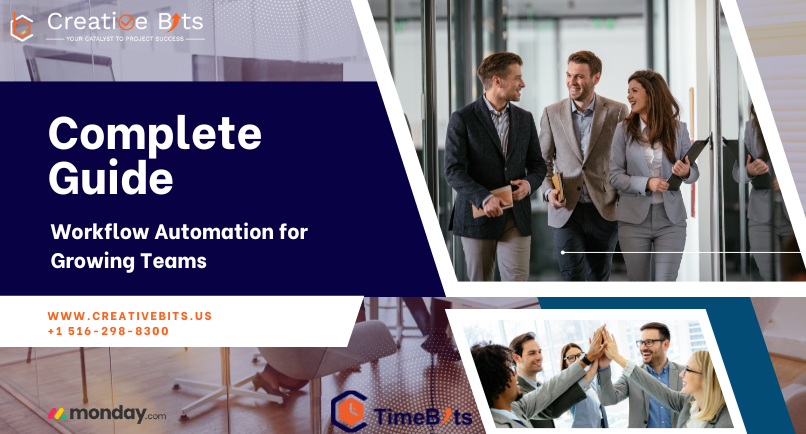Table of Contents
- Why Workflow Automation is Non-Negotiable
- Choosing the Right Automation Tools
- Real-World Use Cases That Drive Results
- Implementation Best Practices
- Getting Started with Workflow Automation
Workflow automation has become the cornerstone of successful business growth in 2025. As teams expand, manual processes that once seemed manageable transform into productivity killers, causing missed deadlines and frustrated employees.
Growing businesses are discovering that implementing workflow automation isn't just beneficial—it's essential for sustainable scaling. Companies using automation report process time reductions of up to 95% and significant drops in operational errors, according to Kogifi research.
1. Why Workflow Automation is Non-Negotiable for Growing Teams {#why-automation}
a) The Breaking Point of Manual Processes
As teams scale beyond 10-15 members, manual processes become exponentially problematic. What worked for small teams—shared documents, email threads, manual task handoffs—crumbles under increased volume and complexity.
Workflow automation addresses these pain points directly:
- Cost Reduction: 20-30% decrease in operational costs
- Time Savings: Up to 95% reduction in routine task completion
- Error Prevention: Elimination of manual input mistakes
- Team Satisfaction: Higher employee engagement and retention
A recent blog b reveals that 66% of businesses now automate at least one core process, proving automation has shifted from a future trend to a current necessity.
b) The Hidden Costs of Not Automating
Without workflow automation, growing teams face:
- Delayed approvals and bottlenecks
- Version control nightmares
- Communication breakdowns between tools
- Unclear task ownership
- Compliance risks
These issues compound as teams grow, making workflow automation the key to the difference between controlled scaling and operational chaos.
2. Choosing the Right Automation Tools Without Overwhelm {#choosing-tools}
a) Start with Process Mapping
Before selecting workflow automation tools, identify your pain points:
- Repetitive Tasks: Invoice processing, order routing, data entry
- Error-Prone Processes: Manual calculations, multi-step approvals
- Time-Consuming Activities: Report generation, status updates
- Cross-Department Handoffs: Sales to fulfillment, support to engineering

b) Essential Features for Growing Teams
When evaluating workflow automation platforms, prioritize:
- No-Code/Low-Code Options: Enable non-technical team members to create automations
- Integration Capabilities: Connect with existing CRMs, communication tools, and financial systems
- Pre-Built Templates: Accelerate deployment with proven workflows
- Scalability: Handle increased volume without performance degradation
- Audit Trails: Maintain compliance and accountability
Platforms like Monday.com, Asana, and Creative Bits Integrated E-commerce OS offer these capabilities, allowing teams to implement workflow automation without extensive technical resources.
c) Implementation Strategy
Successful workflow automation follows this pattern:
- Pilot Project: Start with one high-impact process
- Measure Impact: Track time saved, errors reduced, satisfaction improved
- Iterate and Improve: Refine based on user feedback
- Scale Gradually: Expand to adjacent processes
- Document Everything: Create playbooks for future automations
3. Real-World Use Cases That Drive Results {#use-cases}

a) E-Commerce Operations
Workflow automation transforms e-commerce operations through:
- Order Routing: Automatic assignment based on inventory location
- Inventory Management: Real-time restocking alerts
- Returns Processing: Automated approval and refund workflows
Companies implementing these automations report customer response times dropping from days to hours.
b) Customer Support Excellence
Support teams using workflow automation achieve:
- Intelligent Ticket Routing: Skills-based assignment
- Priority Escalation: Automatic flagging of urgent issues
- Response Templates: Consistent, personalized communications
- SLA Monitoring: Proactive alerts for at-risk tickets
C) Human Resources Transformation
HR departments leverage workflow automation for:
- Onboarding Orchestration: Coordinated multi-department processes
- Document Collection: Automated reminders and validation
- Compliance Tracking: Training requirements and certifications
- Performance Reviews: Scheduled feedback cycles
d) Finance and Operations
Financial teams streamline operations with:
- Invoice Matching: Automatic PO reconciliation
- Approval Workflows: Role-based routing and delegation
- Expense Management: Policy enforcement and reimbursement
- Reporting: Automated dashboard updates
4. Implementation Best Practices {#best-practices}
a) Change Management Essentials
Successful workflow automation requires:
- Executive Sponsorship: Visible leadership support
- Clear Communication: Benefits and expectations
- Training Programs: Hands-on workshops and documentation
- Feedback Loops: Regular check-ins and adjustments
- Success Celebrations: Recognize early wins
b) Governance Framework
Establish clear guidelines for:
- Workflow Ownership: Who maintains each automation
- Escalation Paths: Handling exceptions and errors
- Access Controls: Role-based permissions
- Version Management: Change tracking and rollback procedures
c) Measuring Success
Track these workflow automation metrics:
- Time to Completion: Before vs. after automation
- Error Rates: Manual mistakes eliminated
- Employee Satisfaction: Survey scores and feedback
- ROI Calculations: Cost savings and revenue impact
- Adoption Rates: User engagement and utilization
5. Getting Started with Workflow Automation {#getting-started}
a) Quick Wins for Immediate Impact
Begin your workflow automation journey with these high-impact areas:
- Email Notifications: Replace manual follow-ups with triggered alerts
- Data Entry: Eliminate duplicate input across systems
- Approval Chains: Automate routing based on rules
- Report Generation: Schedule and distribute automatically
- Task Assignment: Use round-robin or skills-based distribution
b) Building Your Automation Roadmap
Create a strategic plan including:
- Current State Assessment: Document existing processes
- Future State Vision: Define ideal workflows
- Priority Matrix: Impact vs. effort analysis
- Resource Planning: Budget and team allocation
- Timeline Development: Phased implementation schedule
c) Partner Selection Criteria
When choosing a workflow automation partner or platform, evaluate:
- Industry Experience: Relevant use cases and references
- Support Quality: Response times and expertise
- Training Resources: Documentation and learning materials
- Community Strength: User forums and best practices
- Pricing Model: Scalability without prohibitive costs
Conclusion: The Automation Imperative
Workflow automation isn't optional for growing teams—it's essential for sustainable success. Organizations implementing comprehensive automation strategies report:
- 95% reduction in process times
- 30% decrease in operational costs
- Significant improvements in employee satisfaction
- Enhanced competitive positioning
The difference between thriving and merely surviving often comes down to how effectively teams leverage workflow automation to eliminate friction, reduce errors, and focus on strategic initiatives.
Are you ready to transform your operations? Creative Bits Integrated E-commerce OS combines delegated approvals, real-time visibility, and reusable templates to help teams scale without chaos.
Schedule a Discovery Call to explore how workflow automation can accelerate your business growth.

 monday.com Services
monday.com Services



